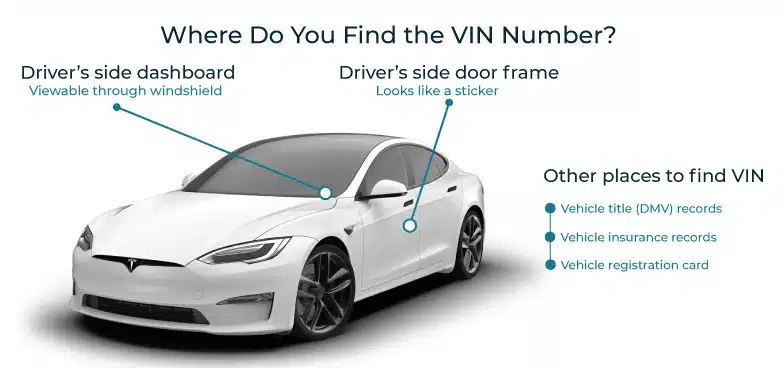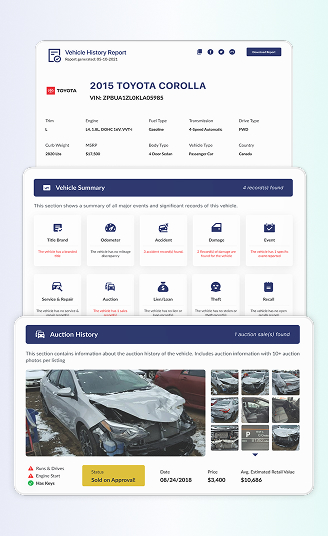
Fisker Recall Check
Stay ahead of danger with a Fisker Recall Check powered by Detailed Vehicle History. Get instant VIN insights, confirm open recalls, and know exactly what to do next. Quick, accurate, and reassuring.
What is a Fisker Recall?
Fisker is the EV startup behind the Ocean SUV. Famous for clean lines, big torque, and clever packaging. But no car is immune to defects.
A Fisker recall is an official safety or compliance action when NHTSA or the manufacturer finds a risk: sudden power loss, warning lights that don’t meet rules, sticky door handles, or even a water pump that can force limp mode. Owners are notified, and the remedy is free, often via software or a part swap.
Fisker’s operating arm filed Chapter 11 in 2024, but recalls still matter because safety duties don’t disappear, and notices/repairs are spelled out by campaign ID.
Why You Should Check the Fisker Recall History With Detailed Vehicle History
Planning to purchase a Fisker? Do a recall check first. Using the Vehicle Identification Number (VIN) ensures hidden defects are fixed for free, protecting your safety and budget.
Below are some reasons why you should check the recall:
Avoid Unsafe Fisker
Fisker recalls happen when a car doesn’t meet safety standards or has defects that could cause harm. From small defects to major safety risks, acting on a Fisker recall quickly prevents accidents, keeps you safe, and guarantees free repairs.
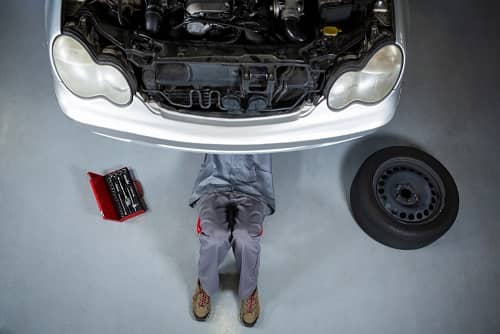

Compliance
Checking a Fisker’s recall history is essential for safety and compliance. Manufacturers must fix defects for free, so staying proactive helps you avoid legal liability, protect resale value, and prevent insurance complications while keeping you and your passengers safe.
Check Common Safety-Related Issues
Checking your Fisker recall history is essential for uncovering safety issues like power loss from a failing water pump, buggy braking behavior, broken door handles, or warning lights that don’t work. Hidden defects may not show immediately, but can lead to danger if ignored. A Fisker recall check keeps you safe, compliant, and confident every time you drive.

How to Run Fisker Recalls?
Get the Fisker recalls report in under a minute by following these simple steps below.

Locate Your Fisker VIN
You'll need your VIN. Look at the driver’s side dashboard near the windshield, the driver’s door jamb or door edge, or your registration, title, or insurance. If you own a Fisker, you can also open the My Fisker app and slide up the bottom bar on the home screen to see your VIN. Our tool supports every Fisker model, classic or current.


Fill in the Form
Begin your Fisker recall check by entering the VIN in the form above. No VIN? Use your license plate number instead for an instant report.


Receive Your Fisker Recall Report
Wait a few seconds for the system to create your Fisker recalls report. When it’s ready, you can review all open and completed recalls right away.
What is on the Fisker Recall Check?
In the Detailed Vehicle History, a Fisker recall check shows detailed information about safety recalls affecting your vehicle. Each record outlines when the recall was announced, which component is impacted, and what action you should take. Such as:
- Date of recalls: Indicates when Fisker and NHTSA issued the recall.
- Affected Component: Lists the exact component, giving clarity on the defect and expected repair process.
- Consequences: Highlights the dangers of ignoring the defect, including accidents or costly damage.
- Next step for the affected Fisker: Confirm if your Fisker is listed under the recall and schedule repairs. With a complete Vehicle Report, you’ll also see past recalls and repair status.
A Fisker vehicle history report also includes mileage records, title check records, auction information, loan and lien records, and more. Review the records below:

Odometer Readings
Track mileage events over time to detect rollbacks or gaps. Consistent readings support a healthy Fisker history and more accurate range/battery expectations.
Title Check Records
Spot salvage, rebuilt, flood, or lemon brands. A branded title changes risk, insurance, and resale. Especially important for an EV that already has open recalls to close.
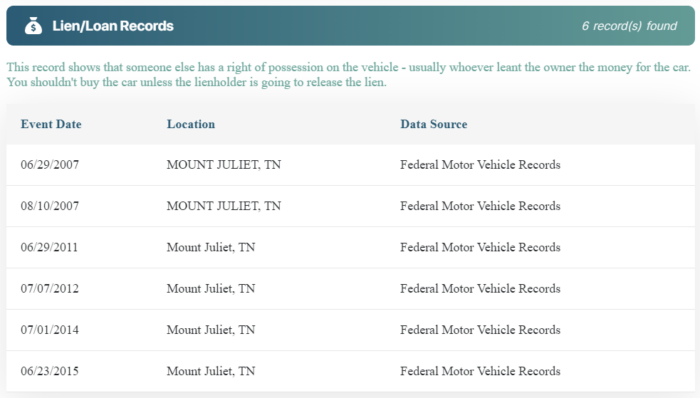
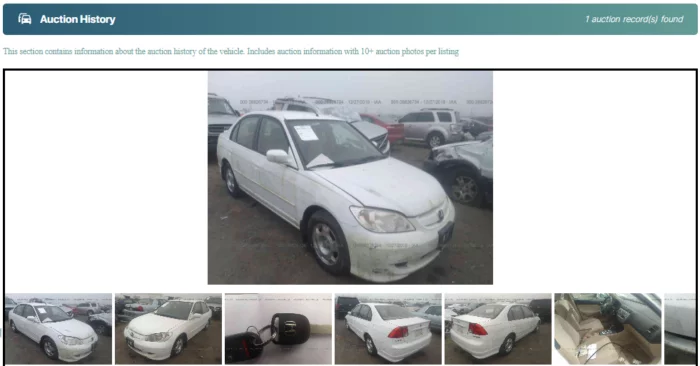
Auction Information
View auction appearances, sale dates, and +10 photos (when available). Great for spotting condition changes around recall or repair timelines.
Loan & Lien Records
Uncover active liens so you don’t inherit someone else’s debt when you buy (or trip up your own sale later).


Accident Records
See verified crash and damage entries tied to your Fisker VIN. Knowing whether an Ocean has structural repairs or airbag deployments helps you judge safety and price before you commit.
Salvage Information
Identify total-loss or dismantler events. A salvage Ocean might still get recall work, but disclosures and safety inspections become even more important.

Common Issues Leading to the Fisker Recall
Below are the main problem groups behind recent Fisker recalls, with short explanations of why they happen, what you might notice, the risk, the free fix, and the official NHTSA ID.
Loss of Propulsion or Forced “Limp” Mode
Software safe state
The powertrain software can push the Ocean into a protection or “safe state” to protect the motor, which cuts drive power until the system is reset. This recall was under NHTSA 24V-404.
You might notice a sudden loss of motive power; regaining drive after cycling power and pressing the brake, before unexpected power loss. Unexpected power loss in traffic can raise crash risk. The remedy is an Over-the-air (OTA) software update; the campaign applies to the 2023 Ocean.
Pump fault
A failure in the cabin electric water pump (EWP_H) can cause a communication loss. The battery system then triggers limp mode, limiting speed to about 10–20 mph. This recall was under NHTSA 24V-499.
You might notice a Sudden speed cap and warnings; the vehicle won’t accelerate normally. Moving much slower than traffic can increase crash risk. The remedy is pump replacement; letters describe the remedy and timing for the 2023–2024 Ocean.
Braking Feels And Regenerative
Braking reduction
The brake module’s software can momentarily reduce negative motor torque (regen), often when braking over bumps, making the car feel like it’s surging even though it isn’t. This recall was under NHTSA 24V-623.
You might notice a brief change in braking feel; drivers still have full friction brakes, but stopping distance can increase. Reduced braking performance can lengthen stopping distance and raise crash risk. Fisker offers OTA software updates as a remedy. The campaign covers the 2023–2024 Ocean (about 7,745 U.S. units).
Unintended Vehicle Movement
Rollaway risk
The transmission may not shift into the selected gear at zero speed, allowing unintended movement in Drive or Reverse. This recall was under NHTSA 24V-865.
You might notice the car doesn’t engage Park, or moves when it shouldn’t at a standstill, which can cause a rollaway that can injure people or damage property. The fix is a software campaign that adds/updates Auto Vehicle Hold logic (OS 2.0) to secure the vehicle. This recall affected around 7,745 units of the 2023–2024 Ocean.
Entry/Exit Problems
Exterior door handles
Some outer door handles were built with dimensional variation in the handle chassis. That extra friction can make a handle stick during deployment or retraction. This recall was under NHTSA 24V-466.
You might notice the handle that won’t open smoothly, or won’t open at all. In an emergency, occupants may be unable to exit (or you can’t enter to help), raising injury risk.
The fix is, Fisker will inspect all four handles using a supplier force-checking tool and replace any that fail; Fisker also issued a mandatory stop-sale for unsold vehicles. Applies to 2023–2024 Ocean.
Other Notable Issues
Driver-information compliance (cluster telltales)
Some instrument-cluster icons (e.g., BRAKE, PARK, ABS) didn’t meet U.S. rules on font height, color, bulb-check behavior, and other FMVSS requirements. This recall was under NHTSA 24V-405. You might notice the warning lights that look different from what you expected or don’t behave correctly at startup.
It can cause drivers can miss critical warnings, which may delay a response to a safety issue. Fisker offers an OTA update to bring the cluster into compliance.
Understanding the Fisker Recall Process
The NHTSA begins the recall process by investigating reported issues. If a defect is found, the manufacturer must issue a recall. See the steps of their process below
Report the Problem
Filing a complaint is the first action you should take. Once submitted, your report is stored in the NHTSA database. When multiple owners report similar issues with the same vehicle, it can indicate a safety defect and may trigger an official investigation.
Investigation
Once a complaint is submitted, the NHTSA follows a multi-step process to determine whether a recall is necessary.
- Screening: Complaints from vehicle owners are examined for credibility and evidence to decide if further investigation is justified
- Analysis: Defect petitions are reviewed in detail. If denied, the decision and reasoning are publicly posted in the Federal Register.
- Investigate the Issues: When Fisker’s safety concerns are confirmed, NHTSA launches a formal investigation, ending in either no defect or a recall.
- Recall Management: NHTSA ensures owners are notified and monitors repair completion rates.
Recalls
A safety recall means the manufacturer must notify owners and fix the issue. Recalls are issued when a vehicle or its parts are unsafe or don’t meet federal rules. Most campaigns are voluntary, and the manufacturer is obligated to make it right, repair or replace the part, refund the cost, or, in some cases, buy back the vehicle.
How Fisker Vehicle Recalls Are Handled?
The NHTSA begins the recall process by investigating reported issues. If a defect is found, the manufacturer must issue a recall. See the steps of their process below
Manufacturer’s Role
Fisker Group Inc. The operating subsidiary of Fisker Inc. filed for Chapter 11 on June 17, 2024. That bankruptcy does not erase safety duties. Under the Safety Act, the manufacturer must
- Decide or report a defect/non-compliance via a Part 573 filing,
- Send owner notification letters within 60 days of that filing, and
- Provide a free remedy if the vehicle is less than 15 years old on the date the defect/non-compliance is determined.
Manufacturers also submit periodic/quarterly completion reports. In practice, the remedy can be a repair, replacement, refund, or buyback, depending on the campaign.
NHTSA’s Role
NHTSA writes and enforces federal safety standards (FMVSS), accepts 573 filings, monitors owner notifications, operates the public VIN-lookup, and can compel or enforce recalls when needed. The agency also investigates defects and tracks completion, using tools that range from investigations to consent orders. In short, NHTSA ensures that owners are told in time, the fix is defined, and the remedy is delivered.
Your Role as the Vehicle Owner
Your job is simple but important: check your VIN, read the letter, book the free fix quickly, and keep the receipt. If your Fisker is older than 15 years at the time the defect is determined, the free-remedy requirement may no longer apply, but safety repairs are still wise.
Re-check periodically (moves and ownership changes can delay mail), and keep your contact info current.
Get the Fisker Window Sticker by VIN
Already checked recalls? Go deeper. A Fisker Window Sticker by VIN reveals the original build: trim, factory options, interior/exterior colors, wheel packages, safety tech, charging equipment, and the original MSRP. It’s the clearest way to confirm the seller’s story and spot missing features that affect value.
Perfect for a complete picture before you buy or sell. Upgrade to get the Fisker Window Sticker by VIN and make every decision easier, faster, and smarter.

Why Use Detailed Vehicle History to Check Fisker Recall?
With Fisker’s unique design and engineering, your vehicle deserves detailed attention. When you use Detailed Vehicle History to check your Fisker recall, you receive not only recall insights but also comprehensive vehicle history, including accident records, title checks, and service history.
This all-in-one report ensures you drive confidently, knowing that you’re making a well-informed decision. Run your Fisker VIN check today for complete peace of mind.
Recall Check For Others Manufacturers
FAQ about Fisker Recalls Check
Are Fisker recall repairs free? Even out of warranty?
Yes. Safety-recall remedies are free as defined in each campaign letter or service bulletin.
Which Fisker models are affected right now?
As of September 2025, the current U.S. campaigns center on 2023–2024 Ocean: loss-of-power software (24V-404), cluster telltales (24V-405), door handles (24V-466), and water-pump/limp-mode (24V-499). Always confirm it with the Fisker Recalls Check by VIN number.
Can I drive my Fisker with an open recall?
It depends. Non-compliant cluster updates are less urgent than power-loss/limp-mode or exit-door concerns. The more critical issues deserve quick scheduling. Follow your campaign letter or see.
How long do Fisker recall fixes take?
OTA updates can be under an hour; water-pump replacement or handle inspections typically take a couple of hours. Your service provider will quote specifics.
Do Fisker recalls “expire”?
Safety recalls don’t expire. Completion logistics can change over time, but VIN checks remain valid, and repairs should be performed as described.
Does bankruptcy change Fisker's recall responsibilities?
Fisker Group Inc. filed for Chapter 11 in June 2024; recall duties continue through formal notices and remedies. That’s why checking your VIN still matters.
Can a salvage/rebuilt-title Fisker still get recall work?
Often yes, as long as the vehicle is safe to service. Confirm with the provider and bring your recall letter.
What if my Fisker recall has no fix yet?
If there’s no remedy yet, the manufacturer still has to notify you, and NHTSA allows time to engineer the fix. You’ll get an interim notice with any short-term safety guidance (for example, reduced use or parking instructions).
When parts or software are ready, you’ll receive a final notice for a free repair. Patience is part of the process. Keep checking your VIN and follow the interim steps in the letter.
What happens if my Fisker is recalled and can’t be fixed?
Federal law gives three remedy paths: repair, replacement, or refund. If a repair can’t reasonably correct the safety defect, the manufacturer may replace the vehicle with a similar one or provide a refund (minus reasonable depreciation), as outlined in recall communications.
Can a dealer sell a used Fisker with an open recall?
Federal law bans the sale of new vehicles with open safety recalls, but it does not ban dealers from selling used vehicles with open recalls. That’s why you should run a VIN check and plan the free recall repair right away.
Will a Fisker recall affect registration, inspection, or insurance?
It depends on your state and your insurer.
- Registration & inspection (state-run): Some states add recall information to renewal notices only. For example:
- California DMV began including safety-recall info on registration renewal notices in 2024 (informational resource, not a block).
- By contrast, New York DMV warns that vehicles with certain high-risk safety recalls may not be able to pass inspection and subsequent registration until repaired.
- Other states explicitly say open recalls don’t stop renewal; Washington notes recall alerts on renewal reminders “will not prevent” registration (“tabs”) renewal.
- Insurance: Insurance is regulated at the state level, so practices vary. (NAIC describes the U.S. system as state-based regulation.) Consumer insurance guidance notes that a recall itself is generally a manufacturer’s responsibility, but if a recall leaves a long-term safety impact or you ignore a fix, it can influence coverage or rates; check with your carrier.
Can independent shops perform Fisker recall repairs, or do I need an authorized provider?
Use Triumph Recall Check to uncover safety issues by VIN, see remedy status, schedule service, and get alerts. Avoid costly surprises and drive with confidence every day.
Are there Fisker recalls on accessories, chargers, tires, or other equipment?
NHTSA recalls can cover more than vehicles; NHTSA also includes tires, child seats, and other motor-vehicle equipment. Search it via Fisker Recall Check by VIN. If an accessory or charger is recalled, it will appear there.
Are there Fisker recalls on accessories, chargers, tires, or other equipment?
Here’s what to have on hand:
- Your VIN (you’ll need it to confirm the campaign on your vehicle).
- The Fisker recall/owner notice for your campaign (if you received one). It includes the NHTSA campaign number (e.g., 24V404/24V466) and Fisker contact details that service staff use when writing up the repair. Example Fisker letters: power-loss (24V404) and door-handle (24V466).
Can I get a loaner vehicle for a Fisker recall repair that takes longer or limits driving?
Loaners aren’t guaranteed by federal law. Some campaigns or dealers offer towing or loaner/rental help; your recall letter or the dealer can tell you what’s available. It’s fine to ask when you book.
Can recalls impact the trade-in value of a Fisker Ocean if they’re still open?
There’s no federal pricing rule, but dealers may discount for open recalls. The simplest way to avoid that is to complete the free recall repair before trading or selling.

